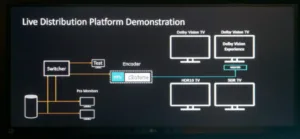Dolby took us on a tour of its booth and most of the time was devoted to audio. Dolby has developed AC-4 ‘next generation’ object-based audio which is one of two standards that have been approved by DVB (the other is MPEG-H) for use as alternative formats (we also heard at the show that DTS is pushing its technology and that the BBC may also have something!)
Dolby has been developing AC-4 for a long time and is ‘ready to ship’ for production. It was used in a live situation at the Roland Garros Tennis tournament this summer. The codec, as well as supporting object-based sound (keeping, for example, commentaries separate from crowd sound to allow alternatives at sports events) is around four times more efficient than AC-3, which means that within the same bandwidth budget, many more options or complexity can be supported. Dolby also has a system that during encoding can identify dialogue and mark the stream with metadata. At the client end, the dialogue can then be boosted using equalisation and other techniques. This allows set makers to add a ‘boost dialogue’ option.
BT Sport has been developing sound using Atmos for sports and special events and Sky recently started tests, as well. In OB vans, a typical arrangement is 5.1.4 which works better in a small space than 7.1.
Moving on to HDR, Dolby was showing a new approach that it has developed. The company has developed technology and is working with compression suppliers (Ateme, Cisco, Elemental, for example) that can use Dolby’s technology to ‘intelligently’ and, more importantly, automatically add dynamic metadata to the broadcast stream at the point that it is compressed. The advantage of this is that the metadata cannot be lost in the production process. At the moment, this is done with a separate box, but in the future the technology will be in the encoder software.
The company has also been talking to Pay TV providers that have controlled environments, with their own STBs. In this case, everything is broadcast in Dolby Vision and the STB then decides how to render this using Dolby’s VS10 technology – to HDR10 or HLG or to SDR according to the capabilities of the consumer’s TV set. That allows a lot of optimisation. VS10 will be available in early 2018 in a Broadcom chip.
“What about HDR10+?”, we asked. Dolby told us that it doesn’t plan to support it but that “We’re pleased that the value of dynamic metadata has been understood”.
Also at the show, Hybrik Inc. said that it would work with Dolby to put Dolby Vision support into its cloud-based transcoding services which are based on Amazon’s AWS platform.
Analyst Comment
Of course, although Dolby told us that it would not support HDR10+. it may come under pressure from service provider customers to do so, so we’ll see if it does. Certainly, the value proposition that is offered by Dolby is quite strong in a pay TV environment and the company has done well to counter the objections around the need for metadata in its system. Metadata is not a problem for offline content where there is a grading process, but in live broadcasting it never looked acceptable, certainly not in Europe, anyway. The need for dynamic metadata was one of the key reasons that an alternative, HLG, was promoted and developed, although there are other advantages to HLG in a production environment, too. (BR)

